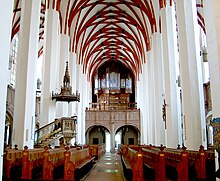Jesu, nun sei gepreiset, BWV 41
| Jesu, nun sei gepreiset | |
|---|---|
| BWV 41 | |
| Chorale cantata by J. S. Bach | |

Thomaskirche, Leipzig
|
|
| Occasion | New Year's Day |
| Performed | 1 January 1725: Leipzig |
| Movements | 6 |
| Cantata text | anonymous |
| Chorale | "Jesu, nun sei gepreiset" by Johannes Hermann |
| Vocal | SATB choir and solo |
| Instrumental |
|
Jesu, nun sei gepreiset (Jesus, now be praised),BWV 41, is a church cantata by Johann Sebastian Bach. He composed the chorale cantata in Leipzig for New Year's Day and first performed it on 1 January 1725 as part of his second cantata cycle. It is based on the hymn by Johannes Hermann (1591).
Bach wrote the cantata in 1724, his second year as Thomaskantor in Leipzig, for New Year's Day. The feast also celebrated the naming and circumcision of Jesus. The prescribed readings for the feast day were from the Epistle to the Galatians, by faith we inherit (), and from the Gospel of Luke, the Circumcision and naming of Jesus ().
That year, Bach composed a cycle of chorale cantatas, begun on the first Sunday after Trinity of 1724. The cantata is based on the hymn for New Year's Day in three stanzas by Johannes Hermann (1591) who was also a Thomaskantor. Its melody is by Melchior Vulpius, who first published it in his Ein schön geistlich Gesangbuch, printed in Jena (1609). The hymn calls Jesus by name first, fitting to the celebration of the naming. Otherwise it is more concerned with the beginning of the New Year. It was popular in Leipzig and was used in two more of Bach's cantatas for the occasion,Singet dem Herrn ein neues Lied, BWV 190 and Gott, wie dein Name, so ist auch dein Ruhm, BWV 171. An unknown poet kept the first and the last stanza as movements 1 and 6, and paraphrased stanza 2 to a sequence of alternating arias and recitatives, expanding the 14 lines by additional ideas, but not specifically referring to the gospel.
...
Wikipedia
